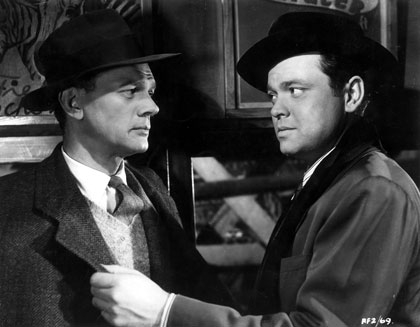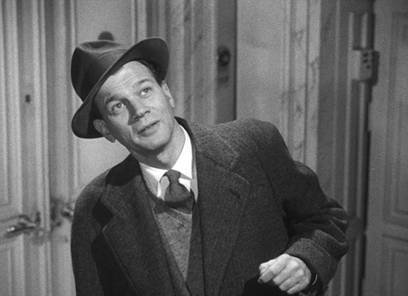The Third Man: Café Vienna Recipe 🥁🥁🥁🥁🥁
/Year Released: 1949
Directed by: Carol Reed
Starring: Joseph Cotten, Orson, Welles, Alida Valli, Trevor Howarda
(Not Rated, 104 min.)

"Don’t part with your illusions. When they are gone, you may still exist, but you have ceased to live." Mark Twain
Savor what may be the most perfect film ever made. This Orson Welles/Joseph Cotten collaboration tops their earlier one, Citizen Kane, even though that one still gets the lion’s share of attention. Love, intrigue, treachery, and betrayal - it literally drips in atmosphere, never sacrificing the great story it has to tell to its dramatic brilliance and avant-garde film techniques.
Hack writer Holly Martin, played to perfection by Joseph Cotten, arrives in post war Vienna to meet up with his ex school chum Harry Lime (Orson Welles), who has offered him a job there. He ends up attending Lime’s funeral instead, and is irked when Major Calloway (Trevor Howard), the British military police officer who gives him a lift to his hotel, tells him his dead friend was “about the worst racketeer that ever made a dirty living in this city.” Hoping to clear his friend’s name in the manor of the pulp Western heroes he writes about, Holly sets out to investigate.
The film gets its name from the mysterious, unidentified “third man” at the accident scene where Harry met his death. Many details seem too coincidental, such as the fact that is was Harry’s own driver who ran him over, and that his doctor, the one who pronounced him dead at the scene, just happened to be in the area when the accident occurred. Now it is not only his reputation that Holly must avenge, but he begins to think it is Harry’s murder as well.
Complicating matters is Harry’s girl, Anna, a sad eyed beauty who Holly falls for – hard. But even the most naively romantic of us know it will never work out. There’s something about the place, war torn Vienna, divided into four sectors by the final victors of World War II, which tells us not to expect a happy ending. If the bombed out buildings and darkened streets are not enough, we have the haunting, hollow zither tune in the background, a tin parody of joy as thin as man’s hope for peace.
Director Reed used expressionistic film techniques to emphasize the distress and confusion of post war Vienna, his wide angled lens as skewed as the lives of its citizens. Not everyone appreciated the Reed’s “habit of printing his scenes askew, with floors sloping at a diagonal and close-ups deliriously tilted,” at the time, but such edginess has so taken root now that it is almost clichéd.
But it is not the techniques that make the film, but its characters, flawed but every bit flesh and blood. Cotten’s Holly Martin is quintessentially American - doggedly loyal, belligerently optimistic, and naively romantic in his blundering way.
Harry Lime is every bit the charming rogue, one who inspires an aloof cat’s devotion as well as that of its mistress, who even when she knows the worst about him, remains true.
In one the film’s most famous scenes, one written by Welles himself, he takes Holly to the top of a Ferris wheel and looks down on the humans below like they are so many little dots. He’s almost convincing as he justifies his corrupt ways:
In Italy for thirty years under the Borgias they had warfare, terror, murder, bloodshed - but they produced Michelangelo, Leonardo da Vinci, and the Renaissance. In Switzerland they had brotherly love, 500 years of democracy and peace, and what did that produce? The cuckoo clock.
The final two scenes are classic as well. Hunted down like the rat he is in the sewers beneath Vienna, Harry has a final confrontation with his now disillusioned old friend, who does him one last favor.
The last scene is another funeral in the same cemetery. The same words are said, the same mourners attend, but it is not so much a man that is dead, but Holly’s illusions.
—Kathy Borich

Film-Loving Foodie
Holly Martin begins his investigations into Harry’s death by talking to one of his friends, a seedy Austrian aristocrat called “Baron” Kurtz. They meet at the outdoors Mozart Café, where Kurtz identifies himself by carrying one of Holly’s latest books, The Oklahoma Kid.
Create your own Vienna experience with this easy to fix Vienna Café, a budget version of the pricey ones at the supermarket or gourmet coffee houses. I’ll bet it is delicious iced as well.
And to go along with this delicious drink, I recommend not one but two great apple strudel recipes.
Café Vienna
1/2 cup instant coffee
2/3 tsp. cinnamon
2/3 cup sugar
1 tsp. dried orange peel
2/3 cup nonfat dry milk
Stir ingredients together. Process in a blender until powdered. Makes 1 1/3 cups mix.
*Attach this note to the jar if making a jar mix:
Use 2 teaspoons to 1 cup of hot water.
Top with whipped cream for a special delight.
Recipe Source: Living on a Dime.com















